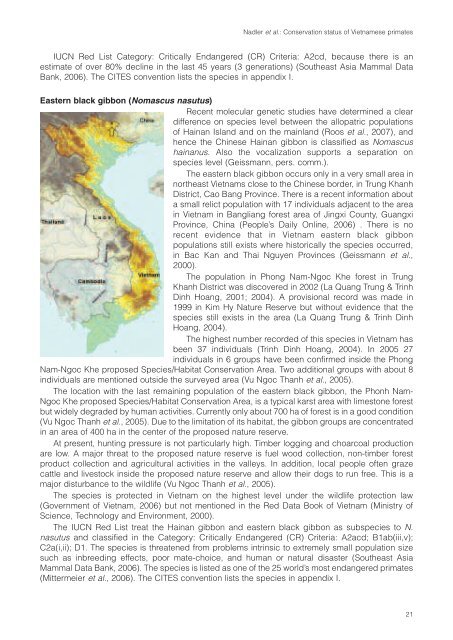Vietnamese Journal of Primatology - Frankfurt Zoological Society
Vietnamese Journal of Primatology - Frankfurt Zoological Society
Vietnamese Journal of Primatology - Frankfurt Zoological Society
You also want an ePaper? Increase the reach of your titles
YUMPU automatically turns print PDFs into web optimized ePapers that Google loves.
Nadler et al.: Conservation status <strong>of</strong> <strong>Vietnamese</strong> primates<br />
IUCN Red List Category: Critically Endangered (CR) Criteria: A2cd, because there is an<br />
estimate <strong>of</strong> over 80% decline in the last 45 years (3 generations) (Southeast Asia Mammal Data<br />
Bank, 2006). The CITES convention lists the species in appendix I.<br />
Eastern black gibbon (Nomascus nasutus)<br />
Recent molecular genetic studies have determined a clear<br />
difference on species level between the allopatric populations<br />
<strong>of</strong> Hainan Island and on the mainland (Roos et al., 2007), and<br />
hence the Chinese Hainan gibbon is classified as Nomascus<br />
hainanus. Also the vocalization supports a separation on<br />
species level (Geissmann, pers. comm.).<br />
The eastern black gibbon occurs only in a very small area in<br />
northeast Vietnams close to the Chinese border, in Trung Khanh<br />
District, Cao Bang Province. There is a recent information about<br />
a small relict population with 17 individuals adjacent to the area<br />
in Vietnam in Bangliang forest area <strong>of</strong> Jingxi County, Guangxi<br />
Province, China (People’s Daily Online, 2006) . There is no<br />
recent evidence that in Vietnam eastern black gibbon<br />
populations still exists where historically the species occurred,<br />
in Bac Kan and Thai Nguyen Provinces (Geissmann et al.,<br />
2000).<br />
The population in Phong Nam-Ngoc Khe forest in Trung<br />
Khanh District was discovered in 2002 (La Quang Trung & Trinh<br />
Dinh Hoang, 2001; 2004). A provisional record was made in<br />
1999 in Kim Hy Nature Reserve but without evidence that the<br />
species still exists in the area (La Quang Trung & Trinh Dinh<br />
Hoang, 2004).<br />
The highest number recorded <strong>of</strong> this species in Vietnam has<br />
been 37 individuals (Trinh Dinh Hoang, 2004). In 2005 27<br />
individuals in 6 groups have been confirmed inside the Phong<br />
Nam-Ngoc Khe proposed Species/Habitat Conservation Area. Two additional groups with about 8<br />
individuals are mentioned outside the surveyed area (Vu Ngoc Thanh et al., 2005).<br />
The location with the last remaining population <strong>of</strong> the eastern black gibbon, the Phonh Nam-<br />
Ngoc Khe proposed Species/Habitat Conservation Area, is a typical karst area with limestone forest<br />
but widely degraded by human activities. Currently only about 700 ha <strong>of</strong> forest is in a good condition<br />
(Vu Ngoc Thanh et al., 2005). Due to the limitation <strong>of</strong> its habitat, the gibbon groups are concentrated<br />
in an area <strong>of</strong> 400 ha in the center <strong>of</strong> the proposed nature reserve.<br />
At present, hunting pressure is not particularly high. Timber logging and choarcoal production<br />
are low. A major threat to the proposed nature reserve is fuel wood collection, non-timber forest<br />
product collection and agricultural activities in the valleys. In addition, local people <strong>of</strong>ten graze<br />
cattle and livestock inside the proposed nature reserve and allow their dogs to run free. This is a<br />
major disturbance to the wildlife (Vu Ngoc Thanh et al., 2005).<br />
The species is protected in Vietnam on the highest level under the wildlife protection law<br />
(Government <strong>of</strong> Vietnam, 2006) but not mentioned in the Red Data Book <strong>of</strong> Vietnam (Ministry <strong>of</strong><br />
Science, Technology and Environment, 2000).<br />
The IUCN Red List treat the Hainan gibbon and eastern black gibbon as subspecies to N.<br />
nasutus and classified in the Category: Critically Endangered (CR) Criteria: A2acd; B1ab(iii,v);<br />
C2a(i,ii); D1. The species is threatened from problems intrinsic to extremely small population size<br />
such as inbreeding effects, poor mate-choice, and human or natural disaster (Southeast Asia<br />
Mammal Data Bank, 2006). The species is listed as one <strong>of</strong> the 25 world’s most endangered primates<br />
(Mittermeier et al., 2006). The CITES convention lists the species in appendix I.<br />
21
















